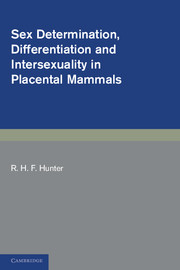Book contents
- Frontmatter
- Contents
- Preface
- Acknowledgements
- List of abbreviations
- List of gene abbreviations
- 1 Historical landmarks in studies of reproduction and sex determination
- 2 Mechanisms of sex determination
- 3 Differentiation of the gonads
- 4 Differentiation of the genital duct system
- 5 Anomalous sexual development in domestic species
- 6 Abnormal sexual development in laboratory rodents
- 7 Abnormal sexual development in man
- 8 Sexual differentiation in chimaeras
- 9 Asymmetries in the reproductive system and their significance
- 10 Concluding thoughts and a current perspective
- Index
- Plate section
7 - Abnormal sexual development in man
Published online by Cambridge University Press: 05 March 2012
- Frontmatter
- Contents
- Preface
- Acknowledgements
- List of abbreviations
- List of gene abbreviations
- 1 Historical landmarks in studies of reproduction and sex determination
- 2 Mechanisms of sex determination
- 3 Differentiation of the gonads
- 4 Differentiation of the genital duct system
- 5 Anomalous sexual development in domestic species
- 6 Abnormal sexual development in laboratory rodents
- 7 Abnormal sexual development in man
- 8 Sexual differentiation in chimaeras
- 9 Asymmetries in the reproductive system and their significance
- 10 Concluding thoughts and a current perspective
- Index
- Plate section
Summary
Est-ce un jeune homme? est-ce une femme,
Une déesse, ou bien un dieu?
L'amour, ayant peur d'être infâme,
Hésite et suspend son aveu.
Dans sa pose malicieuse,
Elle s'étend, le dos tourné
Devant la foule curieuse,
Sur son coussin capitonné.
Pour faire sa beauté maudite,
Chaque sexe apporta son don.
Tout homme dit: C'est Aphrodite!
Toute femme: C'est Cupidon!
(Gautier, 1852)Introduction
Diverse disorders of sexual development exist in man, many of them having been recognised since ancient times and indeed some of them conferring on their possessors positions of dubious privilege in society (Fig. 7.1). Whilst scientific description of the disorders has tended to focus primarily on the condition of the gonads, and may find expression in the external genitalia and non-reproductive tissues, the disorders in fact stem from genetic anomalies involving the chromosome complement or perhaps even individual genes. Such anomalies were first critically analysed in the 1950s with the development of reliable methods for karyotyping and, with the ever increasing sophistication of techniques culminating in those at the molecular level, so the precision of diagnosis has increased. One outcome of the cytogenetic or molecular genetic approach has been the revelation that sexual disorders are frequently a consequence of errors at meiosis in the maternal or paternal germ cell line. Another is the realisation that errors in man usually have their counterparts in laboratory rodents and sometimes also in the large farm animals (see Chapters 5 and 6).
- Type
- Chapter
- Information
- Publisher: Cambridge University PressPrint publication year: 1995

